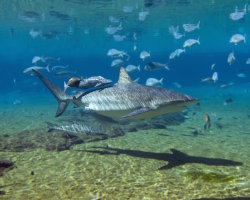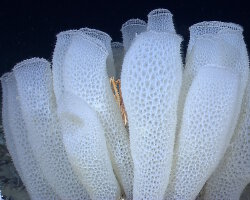Sealife guideThe sea life glossaryOur glossaries
Last updated on 09/03/2025 at 11:27 PM
English
Description
French
Français
adelphophagy, uterine cannibalism
Définition
The consumption of embryos by other embryos or siblings within the parent or egg.
Anglais
embryophagie
Français
amoebocyte
Définition
Movable cell in invertebrates, like sponges, that helps with nutrition, defense and structure.
Anglais
amibocyte
Français
arribada
Définition
A mass synchronized nesting on beaches, where thousands of sea turtles come ashore together to lay their eggs.
Anglais
arribada
Français
autotrophic
Définition
An organism that produces its own food from inorganic substances, typically through photosynthesis or chemosynthesis.
Anglais
autotrophe
Français
bioturbation
Définition
The reworking of soil or sediment by living organisms, such as worms or burrowing animals.
Anglais
bioturbation
Français
bottom-living, demersal
Définition
Living on or near the bottom of a body of water, such as the sea or a lake.
Anglais
benthique
Français
cetaceans
Définition
Marine mammals including whales, dolphins and porpoises.
Anglais
cétacés
Français
choanocyte
Définition
A flagellated cell in sponges that creates water currents and captures food particles.
Anglais
choanocyte
Français
cnidocyte
Définition
A specialized stinging cell found in cnidarians, used for defense and capturing prey.
Anglais
cnidocyte
Français
copepod
Définition
A small, planktonic crustacean that is a key component of aquatic food chains.
Anglais
copépode
Français
coralligenous
Définition
A habitat formed by calcium carbonate deposits from coralline algae, providing structure for marine organisms.
Anglais
coralligène
Français
ctenidium
Définition
A comb-like gill in mollusks used for respiration and sometimes for filtering food.
Anglais
cténidie
Français
diatom
Définition
A microscopic, single-celled algae with a silica-based cell wall, important in aquatic ecosystems as primary producers.
Anglais
diatomée
Français
diploblastic
Définition
Having two primary germ layers, ectoderm and endoderm, during embryonic development.
Anglais
diploblastique
Français
ectoderm
Définition
The outermost layer of cells in an embryo, which gives rise to the skin, nervous system and sense organs.
Anglais
ectoderme
Français
endoderm
Définition
The innermost layer of cells in an embryo, which gives rise to the digestive tract and associated organs.
Anglais
endoderme
Français
endofauna
Définition
Animals that live within the substrate of the seabed, soil or sediment.
Anglais
endofaune
Français
endoskeleton
Définition
An internal skeleton that supports and protects the body of an animal.
Anglais
endosquelette
Français
epifauna
Définition
Animals that live on the surface of the seabed or other substrates.
Anglais
épifaune
Français
epiphyte
Définition
A plant that grows on another plant for physical support but does not take nutrients from it.
Anglais
épiphyte
Français
euryhalin
Définition
Able to tolerate a wide range of salinities in the surrounding water.
Anglais
euryhalin
Français
exoskeleton
Définition
A hard, external skeleton that supports and protects the body of some invertebrates.
Anglais
exosquelette
Français
falciform
Définition
Shaped like a sickle or curved blade.
Anglais
falciforme
Français
frond
Définition
The leaf-like, flattened part of an alga that captures light for photosynthesis.
Anglais
fronde
Français
gamete
Définition
A reproductive cell (sperm or egg) that carries half of an organism's genetic material.
Anglais
gamète
Français
gonad
Définition
An organ that produces gametes (eggs or sperm) for reproduction.
Anglais
gonade
Français
hermaphrodite
Définition
An organism that has both male and female reproductive organs.
Anglais
hermaphrodite
Français
homochromy
Définition
Coloration that allows an animal to blend in with its environment for camouflage.
Anglais
homochromie
Français
IUCN, International Union for Conservation of Nature
Définition
An international organization that assesses the conservation status of species and promotes biodiversity protection.
Anglais
UICN
Français
krill
Définition
Small, shrimp-like marine crustaceans that form a major part of the diet of many whales, fish and seabirds.
Anglais
krill
Français
lamina
Définition
The flat, leaf-like part of an alga that is mainly responsible for photosynthesis.
Anglais
lame
Français
lophophore
Définition
An organ shaped like a crown or a horseshoe, bearing ciliated tentacles arranged around the mouth, serving both to capture food and to breathe.
Anglais
lophophore
Français
mantle
Définition
A layer of tissue in mollusks that secretes the shell and may form a cavity for respiration and excretion.
Anglais
manteau
Français
mesoderm
Définition
The middle layer of cells in an embryo, which gives rise to muscles, bones and the circulatory system.
Anglais
mésoderme
Français
mesoglea
Définition
The jelly-like, non-cellular middle layer of a sponge, located between the outer and inner cell layers.
Anglais
mésogelée
Français
metaphyte
Définition
A simple, primarily plant-like organism, often referring to algae or other non-vascular plants.
Anglais
métaphyte
Français
metazoan
Définition
A multicellular animal with differentiated tissues and organs.
Anglais
métazoaire
Français
Micronesia
Définition
A region of Oceania made up of small islands in the western Pacific Ocean, including the Federated States of Micronesia, Palau and the Marshall Islands.
Anglais
Micronésie (région)
Français
Micronesia
Définition
A country in the western Pacific ocean, officially called the Federated States of Micronesia, composed of over 600 small islands.
Anglais
Micronésie (pays) ou Etats Fédérés de Micronésie
Français
mysticetes
Définition
Baleen whales: large whales that filter-feed using baleen plates instead of teeth.
Anglais
mysticètes
Français
nekton
Définition
Aquatic animals that can actively swim and move independently of water currents.
Anglais
necton
Français
Neptune ball
Définition
A fibrous ball formed from seagrass fragments, rolled and compacted by water, often found on Mediterranean beaches.
Anglais
pelote de mer
Français
Oceania
Définition
A geographic region comprising the islands of the Pacific ocean, including Polynesia, Micronesia and Melanesia.
Anglais
Océanie
Français
ocellus
Définition
A circular, eye-like marking on an animal's body, often used to deter predators or attract mates.
Anglais
ocelle
Français
osculum
Définition
A large opening in a sponge through which water exits after circulating through its body.
Anglais
oscule
Français
ovigerous
Définition
Carrying and protecting eggs until they hatch.
Anglais
ovigère
Français
oviparous
Définition
Laying eggs that develop and hatch outside the parent's body.
Anglais
ovipare
Français
ovoviparous
Définition
Producing eggs that develop and hatch inside the parent's body, resulting in live birth.
Anglais
ovovipare
Français
ovoviviparous
Définition
Producing eggs that hatch inside the parent's body, so young are born live.
Anglais
ovovivipare
Français
pelagic
Définition
Living in the open water, away from the shore and the sea bottom.
Anglais
pélagique
Français
phytoplankton
Définition
Microscopic, photosynthetic organisms that drift in water and form the base of aquatic food chains.
Anglais
phytoplancton
Français
pinacocyte
Définition
A flat, thin cell that forms the outer layer of a sponge, providing protection and structural support.
Anglais
pinacocyte
Français
plankton
Définition
Tiny organisms that drift in water currents, including both plants (phytoplankton) and animals (zooplankton).
Anglais
plancton
Français
porocyte
Définition
A tubular cell in sponges that forms a pore, allowing water to flow into the sponge's body.
Anglais
porocyte
Français
protandrous
Définition
An individual organism that starts life as a male and later may change to a female.
Anglais
protandre
Français
protandry
Définition
A form of sequential hermaphroditism in which an organism starts life as a male and later changes to a female.
Anglais
protérandrie
Français
protogynous
Définition
An individual organism that starts life as a female and later may change to a male.
Anglais
protogyne
Français
protogyny
Définition
A form of sequential hermaphroditism in which an organism starts life as a female and later changes to a male.
Anglais
protogynie
Français
protophyte
Définition
A simple, primarily microscopic, plant-like organism, such as algae or bacteria, that performs photosynthesis or other basic life processes.
Anglais
protophyte
Français
protozoan
Définition
A single-celled, microscopic organism that can move independently and often feeds on organic matter.
Anglais
protozoaire
Français
radula
Définition
A ribbon-like, toothed structure in the mouth of mollusks used for scraping or cutting food.
Anglais
radula
Français
rhinophore
Définition
A sensory tentacle on the head of certain sea slugs and nudibranchs, used to detect chemicals in the water.
Anglais
rhinophore
Français
scale
Définition
A small, rigid plate covering the skin of a fish, providing protection and reducing water resistance.
Anglais
écaille
Français
sessile
Définition
Fixed in one place and not capable of movement.
Anglais
sessile
Français
shade-loving
Définition
An organism that prefers or thrives in shaded or low-light environments.
Anglais
sciaphile
Français
spicule
Définition
A small, needle-like structure that forms part of the skeleton of sponges, providing support and protection.
Anglais
spicule
Français
spongin
Définition
A fibrous protein that forms the flexible skeleton of certain sponges.
Anglais
spongine
Français
stipe
Définition
The stalk or stem that supports the cap of a mushroom or the frond of certain plants and algae.
Anglais
stipe
Français
subtropical
Définition
Located in or characteristic of regions immediately north or south of the tropics, with warm, often humid climates.
Anglais
subtropical
Français
sun-loving
Définition
An organism that prefers or thrives in well-lit or sunny environments.
Anglais
photophile
Français
thallus
Définition
A simple, undifferentiated plant body that lacks true stems, roots and leaves, typical of algae, fungi and some liverworts.
Anglais
thalle
Français
viviparous
Définition
Giving birth to live young that have developed inside the parent's body, rather than laying eggs.
Anglais
vivipare
Français
whalebone plate
Définition
A series of hair-like or comb-like structures in the mouth of baleen whales used to filter food from water.
Anglais
fanon
Français
zoid
Définition
A single-celled organism or animal that has a distinct, independent body capable of movement.
Anglais
zoïde
Français
zooplankton
Définition
Tiny drifting animals in water that feed on phytoplankton and serve as a key food source for larger marine species
Anglais
zooplancton
Looking for the definition of a term but can't find it ? Or want to suggest one ? Contact us and we'll be happy to help !
Our latestUpdates

Friday, December 19th 2025
The magic of Christmas decorations
Discover Christmas decorations in Florida: giant trees, illuminated palm trees, magical light displays and tropical settings to experience the holiday magic under the sun.

Monday, December 15th 2025
The dusky shark
Discover the dusky shark, one of the world's largest coastal sharks, and learn why this powerful predator is essential to marine ecosystems.

Friday, December 12th 2025
Christmas magic at Disney hotels
Experience the magic of Christmas at Disney hotels: enchanting decorations, giant Christmas trees, dazzling lights and a festive holiday atmosphere.
Photo of the Day

Corbeille de Vénus
(Euplectella aspergillum)
(Euplectella aspergillum)
